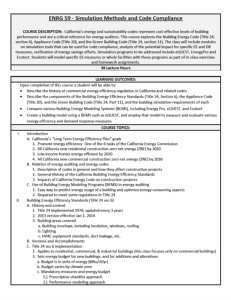ENRG 59: Simulation Methods and Code Compliance

Program Description:
The Commercial Building Energy Analysis and Audits program at City College of San Francisco prepares students to conduct energy audits, evaluate building systems for efficiency, analyze energy data, and apply financial and business strategies in audit reporting. The program is divided into 15 modular courses designed for a community college level student. These courses are adaptable and can be selected, reorganized, or offered in a shorter format to suit individuals with experience in construction, architecture, HVAC, building operations, or mechanical engineering.
Course Description:
This course, from the BEST Center and City College of San Francisco, focuses on simulation methods and code compliance. The course asks students to consider the Building Energy Code (Title 24, section 6), Appliance Code (Title 20), and the Green Building Code (Title 24, section 11). The class includes modules on simulation tools that can be used for code compliance, analysis of the potential impact for specific EE and DR measures, verification of energy savings efforts. Simulation programs to be addressed include eQUEST, EnergyPro and Ecotect. In completing the course, students will be able to:
- Describe the history of commercial energy efficiency regulation in California and related codes.
- Describe the components of the Building Energy Efficiency Standards (Title 24, Section 6), the Appliance Code (Title 20), and the Green Building Code (Title 24, Part 11), and the building simulation requirements of each.
- Compare various Building Energy Modeling Systems (BEMS), including Energy Pro, eQUEST, and Ecotect.
- Create a building model using a BEMS such as eQUEST, and employ that model to measure and evaluate various energy efficiency and demand response measures.
Course Contents:
A course outline and a PowerPoint presentation are included for this course.
The 4-page course outline document includes a course description, learning outcomes, a detailed course topics outline, and more. Topics include: an introduction, Building Energy Efficiency Standards (Title 24 sec 6), Energy Appliance Efficiency Code (Title 20), California Green Building Standards Code (CALGreen) Title 24 section 11, and Building Information Modeling Programs.
The PowerPoint presentation covers how the class is related to California’s Energy Efficiency Plan and energy audits, Building Energy Efficiency Standards -Title 24 section 6, Energy Appliance Efficiency Code-Title 20, California Green Building Standards Code, and building information modeling programs.
For orientation purposes, viewers should begin with ENRG 59_Course Outline_cc.pdf, which offers a description of the course as well as an overview of topics covered through a course outline.
Below is a list of the files contained within the .zip attachment. The size of each file is included in parenthesis.
ENRG-59-Simulation-Methods-Code-Compliance (5 files, 5.4 MB)
- Codes and Simulations (Codes and Simulations Course Content.pdf 2.2 MB)
- Codes and Simulations (Codes and Simulations Course Content.pptx 2.7 MB)
- Course Outline (ENRG 59_Course Outline.docx 25 KB)
- Course Outline (ENRG 59_Course Outline.pdf 366 KB)
About this Resource


Comments